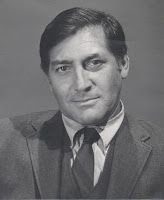Leslie William Nielsen was born in Regina, Saskatchewan on February 11, 1926. Dude was Canadian. I had no idea. He was the second of three boys to his mother, an immigrant from Wales and his father, who was a member of the Royal Canadian Mounted Police.
Nielsen's uncle was Jean Hersholt, a Danish actor who immigrated to America and had made a respectable name for himself in Hollywood. It was from his uncle that Nielsen himself would have aspirations of becoming an actor. In 1994, he told the Boston Globe "I did learn very early that when I would mention my uncle, people would look at me as if I were the biggest liar in the world. Then I would take them home and show them 8x10 glossies, and things changed quite drastically. So I began to think that maybe this acting business was not a bad idea."
 |
| Jean Hersholt in the 1936 film His Brother's Wife. |
Nielsen took up acting after a tour with the Royal Canadian Air Force, enrolling in the Lorne Greene Academy of Radio Arts in Toronto. Really. From there, he received a scholarship to the Neighborhood Playhouse, a professional actor's conservatory in New York City. There he started to land acting jobs. His first role on television was in a 1950 episode of
Studio One, alongside Charlton Heston.
Jobs came easy to Nielsen, who appeared on 46 different television series in 1950 alone. Much of these roles were undistinguished, but they were building for Nielsen the resume of a handsome leading man.
His big break came in 1955, when he was cast in the starring role of the science-fiction classic
Forbidden Planet. The film was an instant success and led to Nielsen becoming a contract player at MGM Studios. Watch a clip of the film
here.
Nielsen spent the next twenty-five years padding his dramatic resume. He appeared in such films as
Hot Summer Night (1957),
How to Commit Marriage (1969) and
The Poseidon Adventure (1972), in which he played the doomed ocean liner's captain, who dies twenty minutes into the film. Watch that death scene
here.
Oddly, a lot of people I know don't realize that he was anything other than a comedic actor, since he was so well known for it. But his transition to comedy came at the end of his career, after having spent three decades amassing a series of dramatic roles. This career shift came in 1980, when he was cast as Dr. Rumack in the comedy classic
Airplane!.
 |
| Dr. Rumack is always there to help. |
The film was a comedic redo of the 1950s Canadian disaster movie
Zero Hour!. Many of the scenes and situations in the film are complete redos, right down to the dialogue. Watch a scene-by-scene comparison
here.
It is in this film that Nielsen uttered the phrase for which he would become famous. Responding to Robert Hays's line "surely you can't be serious," Nielsen's Rumack replies "I am serious. And don't call me Shirley." Watch it
here. When asked about the line years later, Nielsen remarked "I thought it was amusing, but it never occurred to me that it was going to be a trademark. It's such a surprise...the thing comes out, people say, 'What did he say?!'."
Following the film's success, the producers, brothers David and Jerry Zucker, turned their attention to television, creating the cult-classic comedy series
Police Squad. Impressed by Nielsen's earlier performance, the brothers cast him in the lead role of Lieutenant/Sargant/Detective/Whatever Frank Drebin. While I can remember watching the episodes when they aired in 1982, apparently not many other folks were. The series was canceled after just six episodes, a decision that ABC regrets to this day.
Six years later, the brothers brought the franchise back to life with a big-screen adaptation called
The Naked Gun: From the Files of Police Squad. Watch the trailer
here. It was an instant success and spawned two sequels. It also brought Nielsen a score of similar roles in other big budget Hollywood blockbusters, with such films as
Repossessed (1990),
Spy Hard (1997) and the
Scary Movie franchise of the early 2000s.
During that time, Nielsen and his fourth wife Barbara were shuttling between their two homes in Fort Lauderdale, Florida and Paradise Valley, Arizona. It was in the former that in November 2010, Nielsen contracted pneumonia, and was admitted to Holy Cross Hospital. There he passed quite peacefully in his sleep. I wish I could say the same for George Zip.
Nielsen was interred in Fort Lauderdale's Evergreen Cemetery. He's the only celebrity there, and his is one of the easiest graves you'll ever find. Since the entire cemetery is nothing but flat markers, all you have to do is look for his bench.
A jokester to the end, Nielsen's epitaph is a play on the famous "RIP" (Rest in Peace).
Rest in peace, Shirley.
Trivia
- Nielsen's older brother Erik served as Deputy Prime Minister of Canada from 1984 to 1986. Just like Gerald Ford.
- Nielsen was legally deaf and wore hearing aids most of his life.
- Police Squad's intro, wherein a police car would drive through an urban landscape, was based on the 1950s Lee Marvin series M Squad. Click on the titles to watch those respective intros. And just as Airplane! was a comedic redo of the more serious Zero Hour!, Police Squad often lampooned the original source material. Watch a funny side-by-side comparison of the two series here.
- Nielsen was a golf enthusiast who made a series of instructional, albeit entertaining how-to videos. Watch one here.
- In 1993, Nielsen released his memoir The Naked Truth. Pick up a copy here.





















